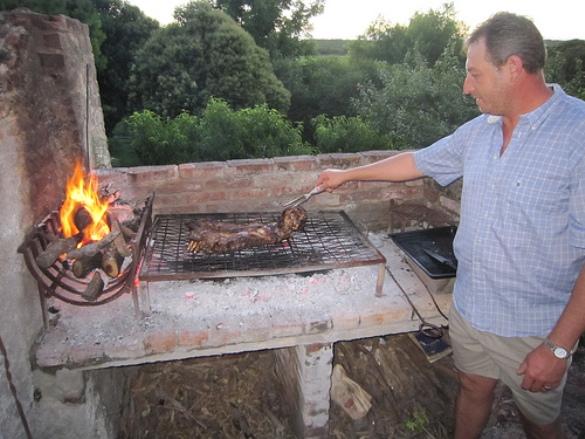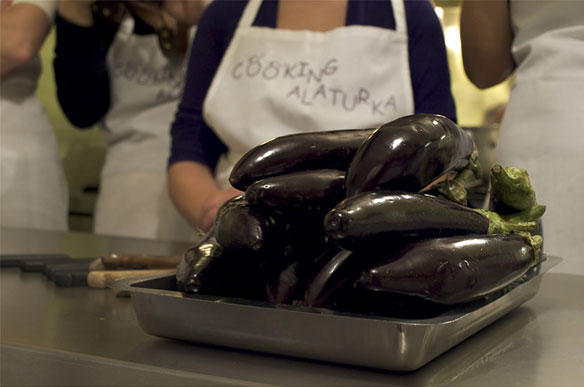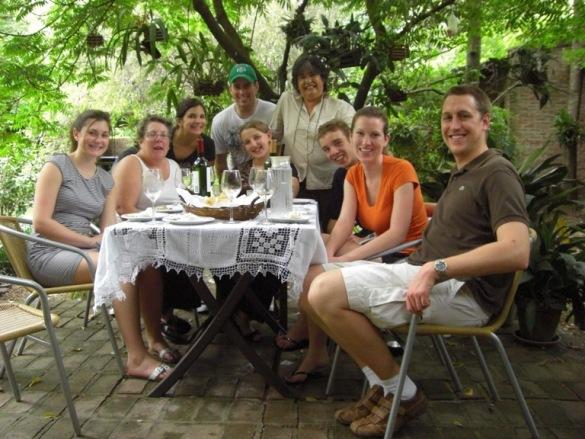What is one thing that people of all nations, colors, and creeds have in common? We all eat. Food unites us all; and a worldly traveler takes advantage of every bite to soak up all that a culture has to offer. From street food prepared for the masses to home-cooked family recipes perfected after generations of fine-tuning – food is the pulse of a culture. Food fortifies, it brings us together, and it is celebrated and cherished.
Eating like a local is an important aspect of getting an accurate look at a culture. And I don’t mean learning to order a hamburger in languages around the world; I’m talking about immersing yourself in a place and a way of life and eating what and how the locals eat.
What is perhaps even more rewarding than eating like a local is understanding the ingredients and care that goes in to the preparation of the local cuisine. Cooking classes abroad are a great way to immerse yourself in a food culture. Learning to cook overseas allows you to bring a piece of a country and its culture home with you to enjoy with friends and family for the rest of your life.
I’ve participated in several cooking classes all over the world and have had an equally delicious experience each time. I learned to make succulent barbeque in Uruguay, spicy Massaman curry in Thailand, luscious stuffed eggplant in Turkey, and crispy filled empanadas in Argentina. While each class was uniquely different, each experience included instruction by a chef native to the country, class participation in preparing the food, and a feast shared with fellow students at the end. In addition to learning how to prepare tantalizing authentic cuisine, a cooking class abroad encourages travelers to try new foods and cooking techniques, teaches respect and understanding for ingredients and indigenous cooking methods, provides a full sensory food experience and is time spent in a personal setting with locals, as well as people from other parts of the world. Through informal conversation over food and wine, cooking classes abroad provide great perspective into other people’s lives and meaningful insight into their cultures.
Be ready for impromptu lessons
Learning to cook abroad doesn’t always require planning, cost money, or involve a deliberate curriculum. Sometimes cooking classes are impromptu. Inquire about ingredients and food preparation, and oftentimes foreign cooks will be so flattered by your interest you’ll receive a lesson complete with juicy information illustrating the cultural importance of specific foods. For instance, at the breathtaking Estancia Tierra Santa in Carmelo, Uruguay, we watched as Roberto, the cassero (ranch hand) took an assortment of meat out of the refrigerator, and (with translation from the Estancia owner) told us all about the Uruguayan national dish, asado, in the estancia’s big, intricately tiled kitchen. ‘The key to a delicious asado is cooking the meats ‘a fuego lento’, or on a slow fire,” he said. “If the coals are too hot, the meat burns outside, and remains raw inside.”
In Uruguay it’s the custom to eat dinner late in the evening. It was nearly 10pm, and as the summer sun began to set, fireflies lit up the darkening countryside panorama. I took a sip of my Tannat, Uruguay’s national wine, which was produced by the estancia’s neighbor and second largest vineyard in Uruguay, the Irurtia Winery. As I enjoyed my wine and watched Roberto skillfully tend the grill, we learned not only about the cooking techniques but also about his his life as a ranch hand, an unexpected lesson in two aspects of the country’s culture.
Participation brings understanding
Learning how other people live is one of my main objectives of travel. The difference between an average tourist and a well-seasoned explorer is participation in a country’s way of life. A tourist travels to observe whereas an explorer travels to actively learn about people and their cultures. An organized cooking class abroad presents a great opportunity to learn the significance of regional ingredients and time-honored methods of indigenous cooking that the typical tourist can’t discover by merely sampling local fare at a restaurant.
At the Samui Institute of Thai Culinary Arts (SITCA) in Koh Samui, Thailand each student is given their own cook station with a stovetop, wok and cooking utensils. All of the cook stations are side by side and encircle an expert Thai cooking instructor. Each student follows the instructor and actually prepares his or her entire meal by themselves.
Thai food is known for its balance of the five fundamental taste senses in each dish or the overall meal: hot (spicy), sour, sweet, salty, and (optional) bitter. Though an emphasis is placed on the balance of the five flavors, Thai food is celebrated for being particularly spicy. It can be adapted and made milder for those with sensitivity to the incendiary flavors of Thai chilies. However, if your taste buds can take the heat, Thai people believe chilies clear the sinuses, boost the immune system, ward off illnesses, and improve cardiovascular health.
In rural areas just about every family grows their own chili bushes and tables aren’t set with salt and pepper shakers but instead with diced chilies swimming in a dish of fish sauce. The chili is revered and used widely in Thai cooking. At SITCA I learned the significance of chilies in Thailand, and got a deeper look into the culture of the area, through the food that the people consumed.
Cooking is a full sensory experience
Whether it’s the fragrance of chilies in a Thai kitchen, the sound of crackling embers of a Uruguayan Parilla, the jovial laughter of fellow pupils, the sight of a full basket of freshly baked Argentinean empanadas, or the feeling of warm olive oil dripping down your chin in Turkey, a cooking class abroad provides a full sensory experience. In order to grasp ideas and concepts, such as cultural understanding, we perceive new information through experiencing the tangible qualities of the world, relying on our senses and immersing ourselves in unfamiliar situations. We learn by feeling, touching, tasting, smelling, seeing, and hearing. Cooking abroad is an opportunity to experience food on a deeper sensory level than the average tourist may be able to.
At Cooking Alaturka in Istanbul, I bit into the tender, flavor-bursting Imam Bayildi, an eggplant braised in olive oil with onion and tomato, as savory olive oil dripped down my chin. The name of the Turkish dish that I had just created under the instruction of Chef Feyzi is literally translated as “the imam (holyman) fainted with joy,” which apparently happened to a Turkish imam as he swooned with pleasure at the flavor of the succulent dish. There in the the historic heart of Istanbul, Turkey, I found that I was a bit light-headed myself.
Be open to trying new things
Travelers are generally adventurers who are not strangers to trying new things. A cooking class abroad encourages travelers to broaden their horizons even wider and try new food, drink, and culinary preparation methods. A cooking class is a perfect environment in which curiosity grows and adventurous eaters become even bolder.
Teresita, the owner of Cooking with Teresita, just outside Buenos Aires, Argentina, teaches how to make two types of empanadas, one with beef filling and the other with humita (sweet corn) filling. Some of the ingredients seemed bizarre to me; raisins, olives and boiled eggs in the beef empanada and sugar on top of the savory humita empanada. At first sight I wouldn’t have ordered these empanadas on a menu in an Argentinean restaurant and I wouldn’t have known what I would be missing.
Instead, we made the empanadas by hand, learning the cultural and historical reasons behind the seemingly strange ingredients and then enjoyed them in the lushly planted garden while talking and laughing with fellow students. The traditional fillings were indeed delicious and mirrored the diversity of the country and the tastes of the various immigrant cultures that make up today’s Argentinean population.
Teresita joined us as we ate and offered an informal lesson on Argentinean wine. We sampled a Malbec, the country’s most popular exported wine, as well as a Torrontes, a distinctive white wine only produced in Argentina. As I sipped the dry, floral wine, I wondered if I would have ever tried Torrontes had I not been a part of Teresita’s cooking class.
A cooking class abroad brings more pleasure and knowledge than merely sampling traditional cuisine in a restaurant overseas. Try new cuisine, learn about regional ingredients and their cultural significance, experience foreign food with all five senses, and most importantly spend time in a personal setting with local people who are willing to share a valuable piece of their lives with you though food.
A cooking class abroad is an excellent opportunity to meet new and interesting people that share a passion for food. Learning about how other people live, think, and eat opens up your eyes to the surprising and amazing world we live in.
If you like to travel and you like to cook, try a cooking class on your next trip abroad. Food is an expression of culture and fully experiencing it will help you gain deeper insight during your travels. By participating in a cooking class abroad you’ll surely learn more about food, yourself, and the world than you ever thought possible in a mere few hours. Bon Appétit!
Have you taken a cooking class abroad? How do you connect to the local food traditions while traveling?
Photos by katmcclymonds, 92 days, kunitsa, final photo by Bethany Smith and may not be used without permission



